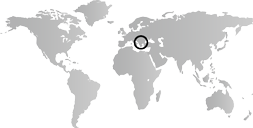In this period, the Balkans forms a frontier between the Ottoman empire and the European powers against which it is constantly at war. Lengthy conflicts in Venice (1644–69) and against the Habsburgs (1683–99) take their toll on the people and the land, and many Christians flee. High taxes imposed by opportunistic Ottoman governors add to the general economic and social malaise; this period witnesses the first stirrings of Balkan nationalism, forcing governmental reforms in the nineteenth century.
The Ottoman capital of Istanbul (in present-day Turkey) is a thriving art center, where masters of painting and calligraphy as well as architects, sculptors, and producers of textiles and objets d’art in many media serve the court or practice in guilds. The non-Muslim community, although minimized since the Ottoman conquest, actively contributes to the artistic output of the region.


